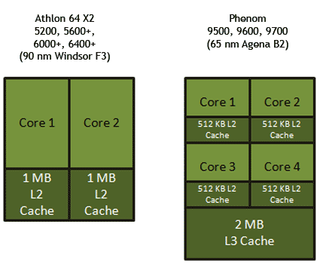Phenom vs. Athlon Core Scaling Compared
A Quick Processor History Lesson

The Athlon 64 family had been superior to Intel's Pentium 4 or Pentium D offerings most of the time from the AMD64 launch in 2003 and Intel's introduction of the Core microarchitecture in 2006. While the Pentium 4 and Pentium D were aimed at reaching high clock speeds, their power requirements grew faster than the performance benefits. As a consequence, AMD's approach of delivering more performance per clock was clearly more successful. Intel realized that a reasonable balance between processing cores and clock speed, based on the available manufacturing technologies, provides a much better path to more performance at reasonable power requirements. This eventually helped the company to get the crown back with Core 2 Duo.
While Intel had mainly been fitting multiple units of its processors into one physical package to create multi core processors - such as the Pentium D 800 at 90 nm and Pentium D 900 at 65 nm - AMD decided to go for more integration right from the start. The first Pentium D held two Pentium 4 units on a single die, but they used the Front Side Bus to communicate. The second generation Pentium D 900 included two dies inside the physical processor. The Athlon 64 X2 dual core also consists of two Athlon 64 cores, but they are on one die, and AMD implemented a crossbar switch as well as a shared memory controller per processor. Inter-core communication hence does not tax the system interface, which is either AMD's HyperTransport or Intel's Front Side Bus.
With the introduction of Core 2 Duo, Intel finally placed two processors together with a unified L2 cache onto a single die, which, among several other improvements, is the secret behind the leading performance per watt ratio of the Core 2 product line. As it makes a lot of sense to accommodate two processor dies inside a processor package to double the core count, Intel approached this strategy to create its Core 2 Quad processor. Essentially, it consists of two Core 2 dual cores and again depends on a fast Front Side Bus when one dual core has to exchange data with the other.
AMD insisted on providing a "true" quad core, which has now been made available as the Phenom processor. While Intel introduced a shared L2 cache (used by all cores) with the Core 2 Duo and pairs two of them to create a quad core unit, AMD went a step farther and added a shared 2 MB L3 cache for all, keeping 512 kB L2 cache per core. Intel's next-generation Core 2 processors, based on the 45 nm Wolfdale core, increase the L2 cache capacity by 50% (6 or 3 MB instead of 4 or 2 MB).
While AMD can control processor characteristics such as clock speed for each core in greater detail, the Agena/Barcelona quad core design is also highly dependent on reliably high manufacturing yield rates. Dysfunctional processing cores on an Agena die force AMD to sell the product as a triple or dual core, while Intel has the flexibility to take any two Core 2 dies to create its quad core units. In theory, AMD's approach offers the better quad core design, while Intel's strategy makes more sense from a business standpoint. Eventually, all we really care about is the result: do the products deliver what their makers promise?


Stay on the Cutting Edge
Join the experts who read Tom's Hardware for the inside track on enthusiast PC tech news — and have for over 25 years. We'll send breaking news and in-depth reviews of CPUs, GPUs, AI, maker hardware and more straight to your inbox.
Current page: A Quick Processor History Lesson
Prev Page How Well Does Phenom Scale With Clock Speed? Next Page Athlon 64 X2 At 2.2, 2.4, 2.6 And 2.8 GHzMost Popular

